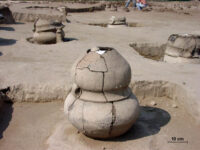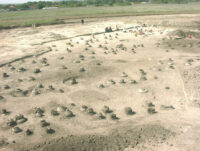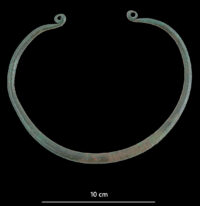 A new study of the cinerary remains found in an urn in the Middle Bronze Age cemetery at Szigetszentmiklós-Ürgehegy in central Hungary has revealed details about the life of an elite woman buried with her twin fetuses.
A new study of the cinerary remains found in an urn in the Middle Bronze Age cemetery at Szigetszentmiklós-Ürgehegy in central Hungary has revealed details about the life of an elite woman buried with her twin fetuses.
The cemetery, just south of modern-day Budapest, was in active use between ca. 2150 and 1500 B.C., the same time span in which the Vatya culture rose and collapsed, and is therefore an important source of archaeological information on Vatya society. The practice of urn cremation was formalized during this period and urnfields with hundreds of burials, almost all of cinerary remains, have been found in the Carpathian Basin. With 525 known burials, Szigetszentmiklós-Ürgehegy is one of the largest Bronze Age burial grounds in Hungary.
 As it is much more difficult to get osteological information from cremated fragments than it is from inhumations, studies of these cemeteries have tended to focus on grave goods and the urns rather than the people buried there. Researchers have now applied strontium isotope analysis, which can determine an individual’s place of origin and movements from the isotope ratios in teeth and bones, to dental remains and the petrous part of temporal bone fragments found in the Szigetszentmiklós-Ürgehegy cremation burials.
As it is much more difficult to get osteological information from cremated fragments than it is from inhumations, studies of these cemeteries have tended to focus on grave goods and the urns rather than the people buried there. Researchers have now applied strontium isotope analysis, which can determine an individual’s place of origin and movements from the isotope ratios in teeth and bones, to dental remains and the petrous part of temporal bone fragments found in the Szigetszentmiklós-Ürgehegy cremation burials.
The study used strontium isotope analysis 41 tissue samples from 29 individuals, 26 of them cremated, three inhumed, to examine how mobility and funerary practices differed between people of different social status, sex and age. Grave 241 was of particular note because it contained the remains of three individuals: a woman between 25 and 35 years of age and two fetuses who were at seven or eight months of gestation when they died. This was the only burial in the study to include more than one individual.
 Her grave goods were also notable. She was buried with a gold hair ring, a bronze neck ring with hammered ends and two carved bone pins or needles. They were mixed with the cinerary remains, suggesting they were part of her dress when she was cremated. The hair ring and neck ring are unique among the Szigetszentmiklós burials, and extremely rare in Vatya cemeteries. These were luxurious objects indicating her high societal status.
Her grave goods were also notable. She was buried with a gold hair ring, a bronze neck ring with hammered ends and two carved bone pins or needles. They were mixed with the cinerary remains, suggesting they were part of her dress when she was cremated. The hair ring and neck ring are unique among the Szigetszentmiklós burials, and extremely rare in Vatya cemeteries. These were luxurious objects indicating her high societal status.
The results of the strontium analysis of her dental and skeletal samples were able to map out the woman’s life from infancy to her last days thanks to the stages of development of bones and teeth.
Strontium isotope analysis of her bone/tooth tissues shows that she might have moved from outside the area to Szigetszentmiklós when she was between 8 and 13 years of age, in the period of the menarche, and therefore at the beginning of the potentially fertile stage of her life. The geographic distribution of the objects which were part of her mortuary parure, and the Ösenring [the bronze neck ring] in particular, may indicate that she had origins in Southern Moravia, Lower Austria or in the upper Danube valley, for example in the Pre-Alpine Bavarian lowlands. All these areas show 87Sr/86Sr baseline which are consistent with the values obtained on her petrous bone. Although archaeological and biogeochemical data converge rather significantly, we must remark that other areas of provenance could not be excluded.
Despite its distribution in more western regions, the gold hair-ring (Noppenring) is quite common in the Carpathian Basin. It is not improbable that the neck-ring and pins/needles were meant to symbolise a link with her native land, whereas the gold hair-ring (a wedding gift?), embodied the new local identity she acquired by joining the Szigetszentmiklós community at the highest rank. However, during adulthood, her life took a tragic turn, when she died (or was killed) whilst pregnant with (or giving birth to) twins.
[T]he ‘life history’ of 241a highlight the social and political role of Bronze Age women as agents of cultural hybridisation and change. Considering the increasing body of evidence about female mobility in this period, we may also argue that the integration into the kinship group of high-ranking women from outside, as a result of marriage exchanges or even rapture, might have been crucial for the emerging elite of the II millennium BC, in order to institute or reinforce political powers and military alliances, but also to secure routes, economic partnerships and, consequently, for exercising the ‘redistributive power’ towards the rest of the population.
The study has been published in the journal PLOS One and can be read here.
I think autocorrect got you on “rapture”.
No, “rapture” is the word in the quoted text.